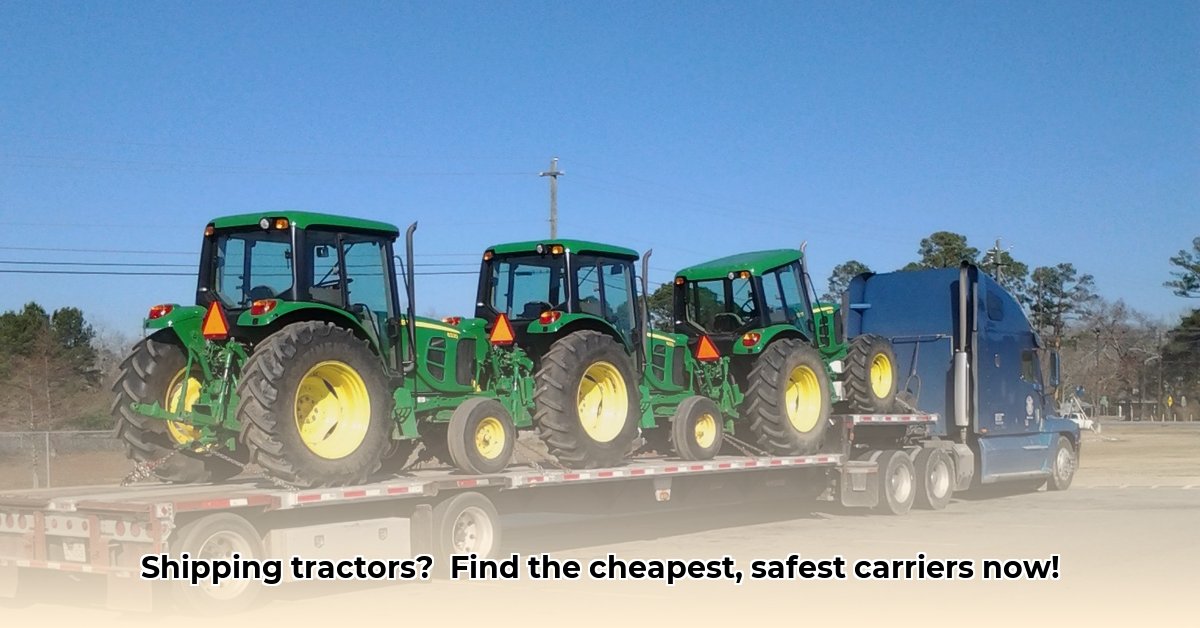
Understanding the Ship Tractor Transportation Market
Shipping a ship tractor isn't a simple task; it demands specialized handling and transportation, significantly impacting costs. Several key factors determine the final price. Distance is a primary driver; longer hauls might be cheaper per mile, but initial empty miles ("deadhead") considerably increase shorter trip costs. Local transport, due to driver time constraints and availability, is significantly more expensive. Think of it as the difference between a cross-country road trip versus many short city drives. For more detailed information on finding reliable carriers, check out this helpful resource: reliable carriers.
The tractor's size and weight are equally crucial. Specialized equipment like flatbed or step-deck trailers are essential, adding to expenses. The type of tractor also matters; specialized agricultural tractors need more specialized handling, further increasing costs. Seasonal demand fluctuates prices; peak seasons (planting/harvest) inflate costs due to high demand. Therefore, off-season shipping often yields substantial savings. Finally, regulatory compliance, including stricter fuel efficiency standards and environmental regulations, impacts fuel costs and available carrier choices. How can you navigate these complexities to secure the best price and ensure reliability?
Key Factors Influencing Ship Tractor Shipping Costs:
- Distance: Longer distances generally lead to higher costs, but the impact of deadhead miles is significant, especially on shorter routes.
- Weight & Dimensions: Larger, heavier tractors require specialized equipment, increasing costs.
- Tractor Type: Specialized tractors often need unique handling, boosting the price.
- Carrier Type: Costs vary significantly across different carriers and their pricing structures.
- Insurance: Insurance costs are directly tied to the tractor's value and desired coverage level.
- Regulations: Compliance with environmental and safety regulations adds cost.
Data-backed rhetorical question: Given the substantial variation in costs, how can shippers effectively compare options and mitigate financial risks?
Quantifiable fact: Studies show that off-season shipping can reduce costs by up to 20%, depending on region and demand.
Finding a Reliable Ship Tractor Carrier: A Step-by-Step Guide
Selecting a trustworthy carrier is as crucial as securing a competitive price. Follow these steps to minimize risks and ensure smooth transportation:
Get Multiple Quotes: Obtain quotes from several carriers to compare prices and services. Use online platforms and leverage competitive bidding to your advantage. (This step enhances transparency and leads to better negotiation leverage.)
Verify Insurance Coverage: Before finalizing, thoroughly verify the carrier's insurance. Ensure it adequately covers your tractor's value during transit. Inadequate insurance could result in substantial financial losses in case of accidents.
Check Safety Records: Research the carrier's safety record. Look for reviews, accident history, and online ratings. A strong safety record is an indicator of reliability and responsible transport practices.
Confirm Specialized Handling: If your tractor needs special handling (due to size, weight, or fragility), ensure the carrier possesses appropriate equipment and experience. This will prevent costly handling issues and potential delays later.
Maintain Clear Communication: Consistent communication ensures you receive timely updates, preventing surprises and allowing swift resolution of potential issues. A strong communication strategy ensures a smoother shipping process.
Cost Breakdown and Future Trends
The cost of ship tractor transport is multifaceted. The table below summarizes the major cost drivers:
| Factor | Impact on Cost |
|---|---|
| Distance | Longer distances inherently increase costs. |
| Weight & Dimensions | Larger tractors require specialized transport, raising costs. |
| Tractor Type | Specialized tractors demand specialized handling and may cost more. |
| Carrier Type | Pricing varies substantially between carriers and their services. |
| Insurance | The tractor's value significantly impacts insurance costs. |
| Regulations | Environmental and safety regulations contribute to overall costs. |
Future trends point towards increased use of digital logistics platforms for enhanced efficiency and real-time tracking. However, this also introduces cybersecurity risks. Stricter environmental regulations will likely push carriers toward fuel efficiency, potentially impacting costs. The integration of smart technologies (GPS, predictive maintenance) will improve efficiency and reduce transportation times.
Expert Quote: "The future of ship tractor transportation hinges on the balance between adopting new technologies to improve efficiency and managing the inherent risks associated with digitalization," says Dr. Anya Sharma, Transportation Logistics Expert at MIT.
Conclusion: Prioritize Safety and Informed Decision-Making
Shipping a ship tractor requires thorough planning and careful consideration of various factors. By following this step-by-step guide, conducting thorough research, and prioritizing reliable carriers, you can effectively manage costs, ensure safe transport, and avoid unexpected challenges. Remember that transparency and safety are paramount.